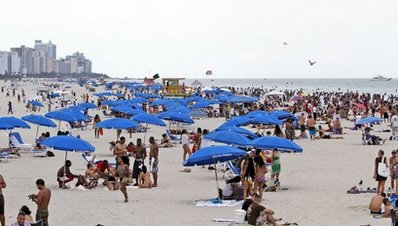Florida coast suffers first impact from oil spill
Jane Ross
PENSACOLA BEACH
Fri Jun 4, 2010
A Great Blue Heron flies past protective booms at Gulf Islands National Seashore in Florida, June 3, 2010. REUTERS/Lee Celano
A Great Blue Heron flies past protective booms at Gulf Islands National Seashore in Florida, June 3, 2010.
Credit: Reuters/Lee Celano
PENSACOLA BEACH Florida (Reuters) – Gooey tar balls and sticky oil sheen washed ashore on a northwest Florida beach among vacationers and swimmers on Friday in what appeared to be the first impact on the tourism-dependent state from the Gulf of Mexico oil spill.
A sign that the impact from the worst U.S. environmental disaster continued to widen, the oil debris came ashore on Pensacola Beach, part of the Gulf Islands National Seashore which advertises “the world’s whitest beaches.”
Florida, the “Sunshine State” with a $60 billion-a-year tourism industry, has been bracing for the arrival of oil from the 46-day-old spill, which has already hit the coasts of Louisiana, Mississippi and Alabama to the west.
Beachgoers on Pensacola Beach, many of them children, were picking up tar blobs scattered along the sugar-white sands. The balls were rust-colored and ranged in size from a button to a table tennis ball.
Grace Vondohlen had a sticky substance on her hands from picking up the tar balls. “It’s pretty sad because we go here on vacation every summer, and now we won’t be able to go any more. I just can’t believe it, because it used to be all just white sand,” she said.
Buck Lee, director of the Santa Rosa Island Authority, said he could not be sure the oil came from the spill leaking from BP Plc’s undersea Gulf of Mexico well off Louisiana “but I’m 90 percent certain that it is.”
The oil would be analyzed to confirm the link with the oil spill, the worst in U.S. history.
Of all the states affected so far, Florida has the most to lose. Tourism is its largest industry, generating $60 billion in spending from more than 80 million visitors a year, bringing in 21 percent of all state sales taxes and employing nearly 1 million Floridians.
A National Park Service spokeswoman in Gulf Breeze confirmed that oil sheen and tar balls had washed ashore on the string of northwest Florida barrier islands.
“I think it’s horrible,” said Anthony Cross, who was walking along Pensacola Beach with his three daughters, holding a child’s fishing net full of tar.
“We just rushed over once we heard that the oil was getting so close. We didn’t expect it to be here,” he said.
“You see shells and jellyfish and trash but I’ve never seen oil here. It’s crazy,” Cross said.
‘JUST BEGINNING’
Florida authorities rushed to implement contingency plans to deal with the arriving oil, sending out cleanup crews and deploying extra protective boom.
“Right now, the state of Florida is seeing impact, it’s time to get the game face on,” said David Halstead, director of the Florida Division of Emergency Management.
Michael Sole, Florida’s secretary of environmental protection, said response teams had been dispatched.
“Its just beginning,” he said.
Florida tourism authorities are rolling out an aggressive advertising campaign, partially funded by BP, aimed at stressing that the state’s beaches remain open for business, despite the pollution threat.
Florida Governor Charlie Crist has asked BP executives for an additional $50 million to fight the encroaching oil, on top of $25 million already received from the company and spent.
Promising “100 percent transparency,” tourism marketing officials are using live video and Twitter feeds so potential visitors can check the status of beaches before booking.
Investment analysts say that since Florida lacks an income tax and is heavily reliant on sales tax revenues, any fall-off in tourism could badly squeeze a state economy still bleeding from a housing market meltdown and the global recession.
Many experts believe crude from the Gulf of Mexico spill may have already been caught up in the powerful Loop Current curling around the Florida Peninsula, which could take it into the Florida Keys and possibly up the East Coast, to Miami.

